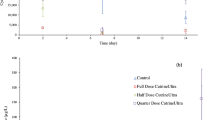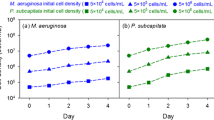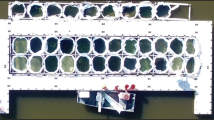Abstract
Since the turn of the century, copper sulfate has been used extensively as an algicide to control nuisance algal blooms in drinking water reservoirs Recent experimental results have shown that the toxicity of copper to algae is determined by the activity of ionic copper, and not the total copper concentration The sensitivity of algae to ionic copper has been found to vary considerably for different algal species Chemical processes such as precipitation, complexation by dissolved organic substances, and adsorption by suspended material can be important in controlling the chemical speciation of copper added to drinking water reservoirs The copper sulfate dosage required for effective treatment of a reservoir is shown to depend on water chemistry and the copper sensitivity of nuisance algal species By evaluating copper chemistry and copper sensitivity of nuisance algal species it may be possible to obtain effective treatment with lower copper sulfate dosages in some reservoirs
Similar content being viewed by others
Literature cited
Allen, M. M. 1973. Methods forCyanophyceae. Pages 127–139in J. R. Stein (ed.) Handbook for phycological methods. Cambridge University Press. New York, NY.
Anderson, D. M., and F. M. M. Morel. 1978. Copper sensitivity ofGonyaulax tamerensis.Limnol. Oceanogr. 23:283–295.
Andrew, R. W., K. E. Biesinger, and G. E. Glass. 1977. Effects of inorganic complexation on the toxicity of copper toDaphnia magna.Water Resour. 11:309–315.
Anonymous. 1976. How to identify and control water needs and algae. Applied Biochemists, Inc. Mequon, WI.
Brugam, R. B. 1978. Human disturbance and historical development of Linsley Long.Ecology 59:19–36.
Button, K. S., H. P. Hostetter, and D. M. Mair. 1977. Copper dispersal in a water-supply reservoir.Water Resour., 11:539–544.
Chau, Y. K., R. Gachter, and K. Lum-Shuc-Chan. 1974. Determination of the apparent complexing capacity of lakewaters.J. Fish. Res. Bd. Can. 31:1515–1519.
Davey, E. W., M. J. Morgan, and J. J. Erikson. 1973. A biological measurement of copper complexion capacity of seawater.Limnol. Oceanogr. 18:993–1977.
Effler, S. W., S. Litten, S. D. Field, T. Tong-Ngork, F. Hale, M. Meyer, and M. Quirk. 1980. Whole lake responses to low level copper sulfate treatment.Water Resour. 14:1489–1499.
Elder, J. F., and A. J. Horne. 1978. Copper cycles and CuSO4 algicidal capacity in two California lakes.Environ. Manage. 2:17–30.
Erickson, S. J., N. Lackie, and T. E. Maloney. 1970. A screening technique for estimating copper toxicity to estuarine phytoplankton.J.W.P.C.F. 42:R271–278.
Fair, M. G., C. J. Geyer, and D. A. Okun. 1971. Elements of water supply and wastewater disposal. John Wiley and Sons, Inc. New York, NY.
Faucher, F. 1978. Personal communication.
Fitzgerald, G. P., and S. L. Faust. 1963. Factors effecting the algicidal and algistatic properties of copper.Appl. Microbiol. 11:345–351.
Fogg, G. E., and D. F. Westlake. 1955. The importance of extracellular products of algae in freshwater.Int. Assoc. Theoret. Appl. Limnol. 12:219–232.
Foster, P. L. 1977. Copper exclusion as a mechanism of heavy metal tolerance in a green alga.Nature 269:332–333.
Gachter, R., K. Lum-Shuc-Chan, and Y. K. Chau. 1973. Complexing capacity of the nutrient medium and its relation to inhibition of algal photosynthesis by copper.Schweizer. Aeits. fur Hydrol. 35:253–260.
Gibson, C. E. 1972. The algicidal effect of copper on a green and blue-green alga and some ecological implications.J. Appl. Ecol. 9:512–518.
Gillespie, P. A., and R. F. Vaccaro. 1978. A bacterial bioassay for measuring the copper-chelation capacity of seawater.Limnol. Oceanogr. 23:543–548.
Guillard, R. R. L. 1973. Methods for microflagellates and nannoplanktons and, Division rates. Pages 87–104, 289–312in J.R. Stein (ed.) Handbook of phycological methods. Cambridge University Press. New York, NY.
Guillard, R. R. L. 1975. Culture of phytoplankton for feeding marine invertebrates, pages 2–60in W.L. Smith and M.H. Chanley (eds) Culture of marine invertebrate animals. Plenum Pub. Co. New York, NY.
Hale, F. E. 1954. The use of copper sulfate in control of microscopic organisms. Phelps Dodge Refining Corp. New York, NY.
Horne, A. J., and C. R. Goldman. 1974. Suppression of nitrogen fixation by blue-green algae in a eutrophic lake with trace additions of copper.Science 183:409–411.
Hoshaw, R. W. and J. R. Rosowski. 1973. Methods for microscopic algae.In J. R. Stein (ed), Handbook of phycological methods. Cambridge University Press. New York, NY.
Lund, J. W. G. 1955. The ecology of algae and waterworks practice.Proc. Soc. Wat. Treat Exam. 4:83–109.
Manahan, S. E., and M. J. Smith. 1973. Copper micronutrient requirements for algae.Environ. Sci. Technol. 7:829–833.
Mandelli, E. F. 1969. The inhibitory effects of copper on marine phytoplankton.Contrib. Mar. Sci. 14:47–57.
Martin, D. F., and W. K. Olander. 1971. Effects of copper, titanium and zirconium on the growth rates of the red tide organisms,Gymnodinium breve.Environ. Lett. 2(3):135–142.
McKnight, D. M. 1979. Interactions between freshwater plankton and copper speciation. Ph.D. thesis. Mass. Inst. Technol., Cambridge, MA. 284 pp.
McKnight, D. M. 1981. Chemical and biological processes controlling the response of a freshwater ecosystem to copper stress: A field study of the CuSO4 treatment of Mill Pond Reservoir, Burlington, Massachusetts.Limnol. and Oceanogr. 26(3):518–531.
McKnight, D. M., and F. M. M. Morel. 1979. Release of weak and strong copper-complexing agents by algae.Limnol. Oceanogr. 24:823–837.
McKnight, D. M., and F. M. M. Morel. 1980. Complexation of copper by siderophores from filamentous blue-green algae.Limnol. Oceanogr. 25:62–71.
Moore, G. T., and K. F. Kellerman. 1905. Copper as an algicide and disinfectant in water supplies.Bull. Bureau Plant Indus. U.S.D.A. 76:19–55.
Morel, F. M. M., N. M. L. Morel, D. M. Anderson, D. M. McKnight, and J. G. Rueter, Jr. 1979. Trace metal speciation and toxicity in phytoplankton cultures.In F. S. Jacoff (ed), Advances in marine research. US Environmental Protection Agency Environ. Res. Lab., Narraganset, RI.
Muchmore, C. B. 1976. Algae control in water supply reservoirs. PB 22–275.
Pagenkopf, G. K., R. C. Russo, and R. V. Thurston. 1974. Effect of complexation on toxicity of copper to fishes.J. Fish Res. Bd. Can. 31:462–465.
Rueter, J. G., Jr., 1979. The effects of copper and zinc on growth rate and nutrient uptake in the marine diatomThalassiosira pseudonana. Ph.D. thesis. Mass. Inst. Technol., Cambridge, MA 155 pp.
Rueter, J. G., Jr., J. J. MaCarthy, and E. J. Carpenter. 1979. The toxic effect of copper onOscillatoria (Trichodesmium)theibautii.Limnol. Oceanogr. 24:558–561.
Rueter, J. G., Jr., S. W. Chisholm, and F. M. M. Morel. 1981. The effect of copper toxicity on silicic acid uptake and growth inThalassiosira pseudonana (Bacillariophyceae).J. Phycol. 17:270–278.
Sanchez, I., and G. F. Lee. 1978. Environmental chemistry of copper in Lake Monona, Wisconsin.Wat. Res. 12:889–903.
Schindler, P. W., B. Furst, R. Dick, and P. U. Wolf. 1979. Ligand properties of surface silanol groups. I. Surface complex formation with Fe3+, Cu2+, Cd2+, and Pb2+.J. Colloid. Inter. Sci. 55:469–475.
Shapiro, J., V. Lamarra, and M. Lynch. 1975. Biomanipulation: An ecosystem approach to lake restoratioin. Pages 85–96in P. L. Brezonik and J. L. Fox (eds) Proceedings of a symposium on water quality management through biological control. University of Florida and US Environmental Protection Agency.
Smith, R. G., Jr. 1976. Evaluation of combined applications of ultrafiltration and complexation capacity techniques to natural waters.Anal. Chem. 48:74–76.
Steemann-Nielsen, E. and J. Bruun-Larsen. 1976. Effect of CuSO4 on the photosynthetic rate of phytoplankton in four Danish Lakes.Oikos 27:239–242.
Steemann-Nielsen, E., L. Kamp Nielsen, and S. Wium Anderson. 1969. Influence of deleterious concentrations of copper on the photosynthesis ofChlorella pyrenoidosa.Physio. Plant. 22:1121–1133.
Steeman Nielsen, E. and S. Wium Anderson. 1970. Copper ions as poison in the sea and freshwater.Mar. Biol. 6:93–97.
Stiff, M. J. 1970. Copper/bicarbonate equilibria in solutions of bicarbonate ion at concentrations similar to those found in natural waters.Wat. Res. 5:171–176.
Stiff, M. J. 1971. The chemical states of copper in polluted freshwater and a scheme of analysis to differentiate them.Wat. Res. 5:585–599.
Stokes, P. M., T. C. Hutchinson, and K. Krauter. 1973. Heavy-metal tolerance in algae isolated from contaminated lakes near Sudbury, Ontario.Can. J. Bot. 51:2155–2168.
Stumm, W., and P. Baccini. 1978. Man-made chemical perturbation of lakes. Pages 91–123in A. Lerman (ed), Lakes—Chemistry, geology, physics. Springer-Verlag New York, NY.
Sunda, W. G., and R. R. L. Guillard. 1976. Relationship between cupric ion activity and the toxicity of copper to phytoplankton.J. Mar. Res. 34:511–529.
Sunda, W. G., and P. J. Hanson. 1979. Chemical speciation of copper in river water: effect of total copper, pH, carbonate and dissolved organic matter.In E. A. Jenne ed, Chemical modeling—speciation, sorption, solubility, and kinetics in aqueous systems. Am. Chem. Soc. Envir. Geochem. Health.
Sunda, W. G., and J. A. M. Lewis. 1978. Effect of complexation by natural organic ligand on the toxicity of copper to a unicellular alga,Monochrysis lutheri.Limnol. Oceanogr. 23:870–876.
Vuceta, J. 1976. Adsorption of Pb(II) and Cu(II) on a-quartz from aqueous solutions: Influence of pH, ionic strength and complexing ligands. Ph.D. thesis. Calif. Inst. Technol., Pasadena, CA.
Waiwood, K. G., and F. W. H. Beamish. 1978. Effects of copper, pH and hardness on the critical swimming performance of rainbow trout (Salmo gairdneri Richardson).Wat. Res. 12:611–619.
Whitaker, J., J. Barica, H. Kling, and M. Buckley. 1978. Efficiency of copper sulfate in the suppression ofApahizomenon flos-aquae blooms in prairie lakes.Environ. Pollut. 15:185–194.
Whitton, B. A. 1973. Freshwater plankton. Pages 353–367in N. G. Carr and B. A. Whitton (eds) The biology of blue-green algae. Univ. Calif. Bot. Monogr. 9.
Author information
Authors and Affiliations
Rights and permissions
About this article
Cite this article
McKnight, D.M., Chisholm, S.W. & Harleman, D.R.F. CuSO4 treatment of nuisance algal blooms in drinking water reservoirs. Environmental Management 7, 311–320 (1983). https://doi.org/10.1007/BF01866913
Issue Date:
DOI: https://doi.org/10.1007/BF01866913




